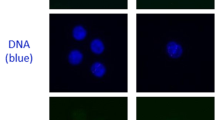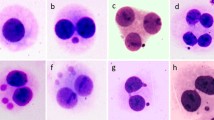Abstract
Provided that a selective accumulation of 10B-containing compounds is introduced in tumor cells, following irradiation by thermal neutrons produces high-LET alpha-particles (4He) and recoiling lithium-7 (7Li) nuclei emitted during the capture of thermalized neutrons (0.025 eV) from 10B. To estimate the biological effectiveness of this boron neutron capture [10B(n,α)7Li] reaction, the chromosome aberration assay and the flow cytometry apoptosis assay were applied. At the presence of the clinically used compounds BSH (sodium borocaptate) and BPA (p-boronophenylalanine), human lymphocytes were irradiated by sub-thermal neutrons. For analyzing chromosome aberrations, human lymphocytes were exposed to thermally equivalent neutron fluences of 1.82 × 1011 cm−2 or 7.30 × 1011 cm−2 (corresponding to thermal neutron doses of 0.062 and 0.248 Gy, respectively) in the presence of 0, 10, 20, and 30 ppm of BSH or BPA. Since the kerma coefficient of blood increased by 0.864 × 10−12 Gy cm2 per 10 ppm of 10B, the kerma coefficients in blood increase from 0.34 × 10−12 cm2 (blood without BSH or BPA) up to 2.93 × 10−12 Gy cm2 in the presence of 30 ppm of 10B. For the 10B(n, α)7Li reaction, linear dose–response relations for dicentrics with coefficients α = 0.0546 ± 0.0081 Gy−1 for BSH and α = 0.0654 ± 0.0075 Gy−1 for BPA were obtained at 0.062 Gy as well as α = 0.0985 ± 0.0284 Gy−1 for BSH and α = 0.1293 ± 0.0419 Gy−1 for BPA at 0.248 Gy. At both doses, the corresponding 10B(n, α)7Li reactions from BSH and BPA are not significantly different. A linear dose–response relation for dicentrics also was obtained for the induction of apoptosis by the 10B(n, α)7Li reaction at 0.248 Gy. The linear coefficients α = 0.0249 ± 0.0119 Gy−1 for BSH and α = 0.0334 ± 0.0064 Gy−1 for BPA are not significantly different. Independently of the applied thermal neutron doses of 0.062 Gy or 0.248 Gy, the 10B(n, α)7Li reaction from 30 ppm BSH or BPA induced an apparent RBE of about 2.2 for the production of dicentrics as compared to exposure to thermal neutrons alone. Since the apparent RBE value is defined as the product of the RBE of a thermal neutron dose alone times a boron localization factor which depends on the concentration of a 10B-containing compound, this localization factor determines the biological effectiveness of the 10B(n, α)7Li reaction.


Similar content being viewed by others
References
Barth RF, Coderre JA, Vicente MGH, Blue TE (2005) Boron neutron capture therapy of cancer: current status and future prospects. Clin Cancer Res 11:3987–4002
Barth RF, Vicente MGH, Harling OK, Kiger WS, Riley KJ, Binns PJ, Wagner FM, Suzuki M, Aihara T, Kato I, Kawabata S (2012) Current status of boron neutron capture therapy of high grade gliomas and recurrent head and neck cancer. Radiat Oncol 7:146. doi:10.1186/1748-717X-7-146
Baumgartner A, Sampol Lopez M, Cemeli E, Schmid TE, Evans AA, Donahue RE, Anderson D (2012) Genotoxicity assessment of Birch-Bark Tar: a most versatile prehistoric adhesive. Adv Anthropol 2:49–56
Belloni P, Meschini R, Czene S, Harms-Ringdahl M, Palitti F (2005) Studies on radiation-induced apoptosis in G0 human lymphocytes. Int J Radiat Biol 81:587–599
Belloni P, Meschini R, Levinska D, Palitti F (2008) Apoptosis preferentially eliminates irradiated G0 human lymphocytes bearing dicentric chromosomes. Radiat Res 169:181–187
Brenner DJ, Sachs RK (1994) Chromosomal ‘fingerprints’ of prior exposure to densely ionizing radiation. Radiat Res 140:134–142
Cebulska-Wasilewska A, Niedzwiedz W, Wierzewska A, Capala BJ, Coderre JA (2000) Biological efficiency of the therapeutic neutron on DNA and cytogenetic damage in the presence and absence of 10B. Report 1869/b; Krakow, Poland. www.ifj.edu.pl/reports/2000.html
Coderre JA, Morris GM (1999) The radiation biology of boron neutron capture therapy. Radiat Res 151:1–18
Coderre JA, Makar MS, Micca PL, Nawrocky MM, Liu HB, Joel DD, Slatkin DN, Amols HI (1993) Derivations of relative biological effectiveness for the high-LET radiations produced during boron neutron capture irradiations of the 9L rat gliosarcoma in vitro and in vivo. Int J Radiat Oncol Biol Phys 27:1121–1129
IAEA (1986) Biological dosimetry: Chromosomal aberration analysis for dose assessment. Technical report serious 260 of the International Atomic Energy Agency, Vienna
IAEA (2001) Cytogenetic analysis for radiation dose assessment. Technical report series 405 of the International Atomic Energy Agency, Vienna
ICNCT-16 (2014) 16th international congress on neutron capture therapy, Helsinki, Finland, 14.-19.6.2014. Book of abstracts. http://icnct16.org
ICRP (2003) Relative biological effectiveness (RBE), quality factor (Q), and radiation weighting factor (wR) publication 92 of the International commission on radiological protection. Pergamon Press, Oxford
ICRU (1992) Photon, electron, proton, and neutron interaction data for body tissues. International Commission on Radiation Units and Measurements. Report 46, Bethesda, MD, U.S.A
Kanda R, Jiang T, Hayata I, Kobayashi S (1994) Effects of colcemid concentration on chromosome aberration analysis in human lymphocytes. J Radiat Res 35:41–47
Kugler U, Bauchinger M, Schmid E, Göggelmann W (1987) The effectiveness of S9 and microsomal mix on activation of cyclophosphamide to induce genotoxicity in human lymphocytes. Mutat Res 187:151–156
Meijer AE, Kronqvist USE, Lewensohn R, Harms-Ringdahl M (1998) RBE for the induction of apoptosis in human peripheral lymphocytes exposed in vitro to high LET radiation generated by accelerated nitrogen ions. Int J Radiat Biol 73:169–177
Mozdarani H, Gharaeian P (2008) Modulation of gamma-ray induced apoptosis in human lymphocytes by famotidine and vitamin C. Mutat Res 649:71–78
Sasaki MS (2001) Radiation cytogenetics database http://house.rbc.kyoto-u.ac.jp/db/MSSFiles/Thermal.html
Sasaki MS, Ende S, Ejima Y, Saito I, Okamura K, Oka Y, Hoshi M (2006) Effective dose equivalent of A-bomb radiation in Hiroshima and Nagasaki as assessed by chromosomal effectiveness of spectrum energy photons and neutrons. Radiat Environ Biophys 45:79–91
Schmid TE, Oestreicher U, Molls M, Schmid E (2011) Alpha particles induce different F values in monocellular layers of settled and attached human lymphocytes. Radiat Res 176:226–233
Schmid E, Wagner FM, Canella L, Romm H, Schmid TE (2013) RBE of thermal neutrons for induction of chromosome aberrations in human lymphocytes. Radiat Environ Biophys 52:113–121
Vermes I, Haanen C, Reutelingsperger C (2000) Flow cytometry of apoptotic cell death. J Immun Methods 243:167–190
Vulpis N (1973) Chromosome aberrations induced in human peripheral blood lymphocytes using heavy particles from the 10B (n, α)7Li reaction. Mutat Res 18:103–111
Acknowledgments
We are greatly indebted to Prof. Rolf Barth, Department of Pathology, The Ohio State University, Columbus, USA, for the friendly support of this investigation. We also thank Dr. C. Greubel, Institute for Applied Physics and Metrology, Universität der Bundeswehr München Neubiberg, Germany, for statistical advice. This work was supported by the DFG Cluster of Excellence: Munich-Centre for Advanced Photonics.
Author information
Authors and Affiliations
Corresponding author
Rights and permissions
About this article
Cite this article
Schmid, T.E., Canella, L., Kudejova, P. et al. The effectiveness of the high-LET radiations from the boron neutron capture [10B(n,α)7Li] reaction determined for induction of chromosome aberrations and apoptosis in lymphocytes of human blood samples. Radiat Environ Biophys 54, 91–102 (2015). https://doi.org/10.1007/s00411-014-0577-y
Received:
Accepted:
Published:
Issue Date:
DOI: https://doi.org/10.1007/s00411-014-0577-y




